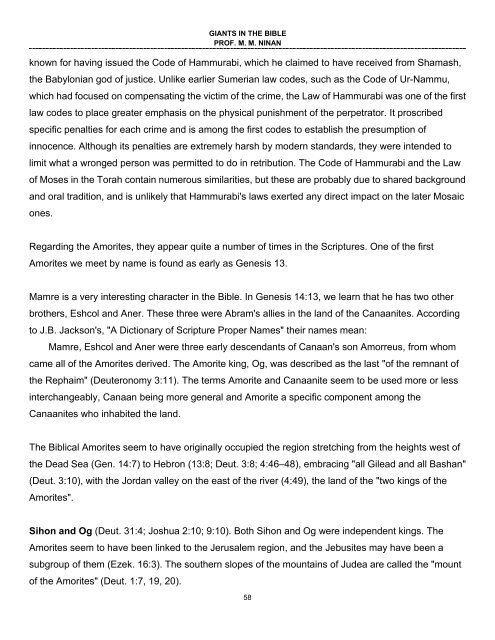Giants_in_the_Bible
Nephilims were on the earth, before and after the flood. Who are these giants? Were there other giant tribes and nations on the earth. How did they happen? A scriptural review on giants on earth.
Nephilims were on the earth, before and after the flood. Who are these giants? Were there other giant tribes and nations on the earth. How did they happen? A scriptural review on giants on earth.
Create successful ePaper yourself
Turn your PDF publications into a flip-book with our unique Google optimized e-Paper software.
GIANTS IN THE BIBLE<br />
PROF. M. M. NINAN<br />
known for hav<strong>in</strong>g issued <strong>the</strong> Code of Hammurabi, which he claimed to have received from Shamash,<br />
<strong>the</strong> Babylonian god of justice. Unlike earlier Sumerian law codes, such as <strong>the</strong> Code of Ur-Nammu,<br />
which had focused on compensat<strong>in</strong>g <strong>the</strong> victim of <strong>the</strong> crime, <strong>the</strong> Law of Hammurabi was one of <strong>the</strong> first<br />
law codes to place greater emphasis on <strong>the</strong> physical punishment of <strong>the</strong> perpetrator. It proscribed<br />
specific penalties for each crime and is among <strong>the</strong> first codes to establish <strong>the</strong> presumption of<br />
<strong>in</strong>nocence. Although its penalties are extremely harsh by modern standards, <strong>the</strong>y were <strong>in</strong>tended to<br />
limit what a wronged person was permitted to do <strong>in</strong> retribution. The Code of Hammurabi and <strong>the</strong> Law<br />
of Moses <strong>in</strong> <strong>the</strong> Torah conta<strong>in</strong> numerous similarities, but <strong>the</strong>se are probably due to shared background<br />
and oral tradition, and is unlikely that Hammurabi's laws exerted any direct impact on <strong>the</strong> later Mosaic<br />
ones.<br />
Regard<strong>in</strong>g <strong>the</strong> Amorites, <strong>the</strong>y appear quite a number of times <strong>in</strong> <strong>the</strong> Scriptures. One of <strong>the</strong> first<br />
Amorites we meet by name is found as early as Genesis 13.<br />
Mamre is a very <strong>in</strong>terest<strong>in</strong>g character <strong>in</strong> <strong>the</strong> <strong>Bible</strong>. In Genesis 14:13, we learn that he has two o<strong>the</strong>r<br />
bro<strong>the</strong>rs, Eshcol and Aner. These three were Abram's allies <strong>in</strong> <strong>the</strong> land of <strong>the</strong> Canaanites. Accord<strong>in</strong>g<br />
to J.B. Jackson's, "A Dictionary of Scripture Proper Names" <strong>the</strong>ir names mean:<br />
Mamre, Eshcol and Aner were three early descendants of Canaan's son Amorreus, from whom<br />
came all of <strong>the</strong> Amorites derived. The Amorite k<strong>in</strong>g, Og, was described as <strong>the</strong> last "of <strong>the</strong> remnant of<br />
<strong>the</strong> Rephaim" (Deuteronomy 3:11). The terms Amorite and Canaanite seem to be used more or less<br />
<strong>in</strong>terchangeably, Canaan be<strong>in</strong>g more general and Amorite a specific component among <strong>the</strong><br />
Canaanites who <strong>in</strong>habited <strong>the</strong> land.<br />
The Biblical Amorites seem to have orig<strong>in</strong>ally occupied <strong>the</strong> region stretch<strong>in</strong>g from <strong>the</strong> heights west of<br />
<strong>the</strong> Dead Sea (Gen. 14:7) to Hebron (13:8; Deut. 3:8; 4:46–48), embrac<strong>in</strong>g "all Gilead and all Bashan"<br />
(Deut. 3:10), with <strong>the</strong> Jordan valley on <strong>the</strong> east of <strong>the</strong> river (4:49), <strong>the</strong> land of <strong>the</strong> "two k<strong>in</strong>gs of <strong>the</strong><br />
Amorites".<br />
Sihon and Og (Deut. 31:4; Joshua 2:10; 9:10). Both Sihon and Og were <strong>in</strong>dependent k<strong>in</strong>gs. The<br />
Amorites seem to have been l<strong>in</strong>ked to <strong>the</strong> Jerusalem region, and <strong>the</strong> Jebusites may have been a<br />
subgroup of <strong>the</strong>m (Ezek. 16:3). The sou<strong>the</strong>rn slopes of <strong>the</strong> mounta<strong>in</strong>s of Judea are called <strong>the</strong> "mount<br />
of <strong>the</strong> Amorites" (Deut. 1:7, 19, 20).<br />
58

















